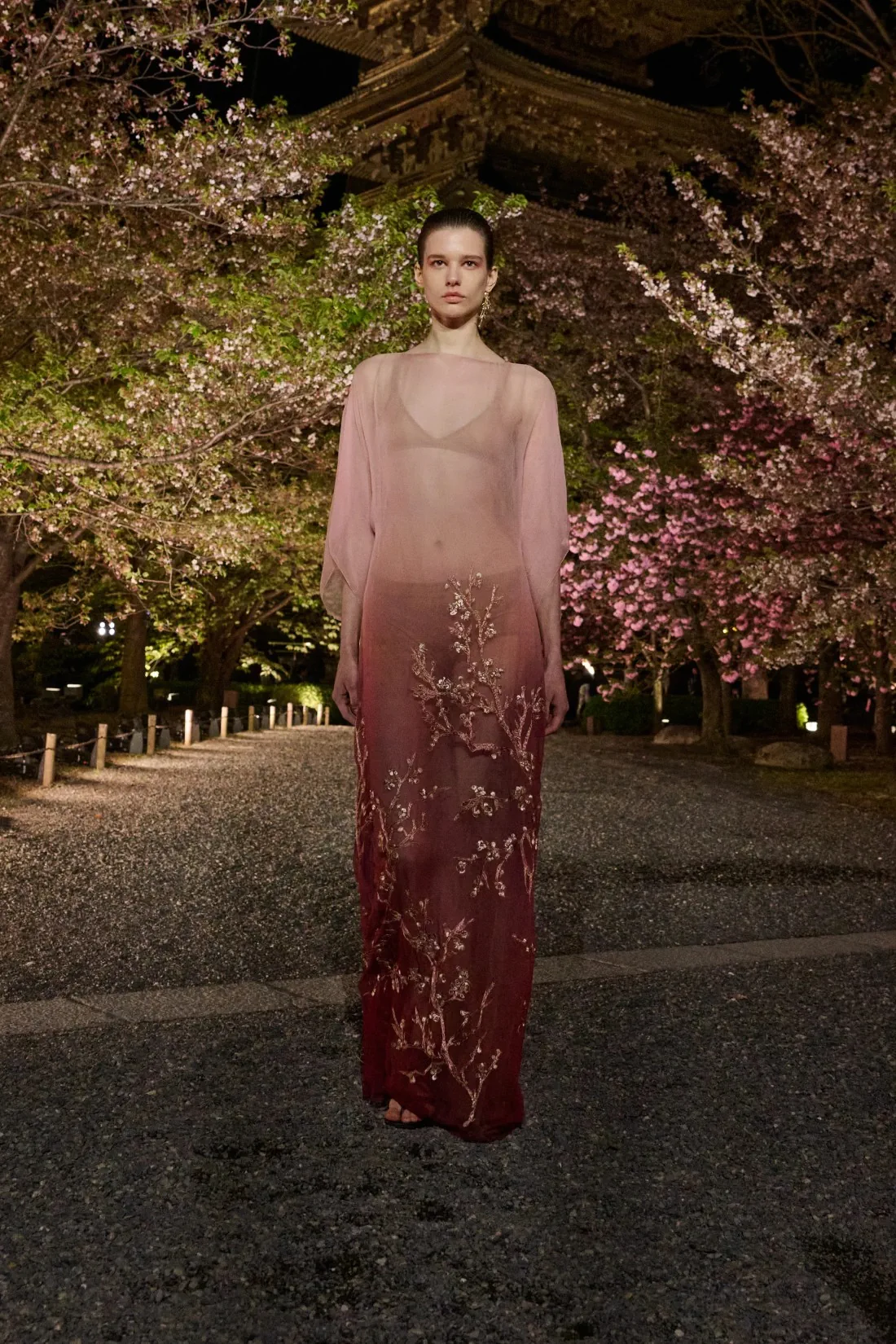Dior Pre-Fall 2025 transformed Kyoto’s historic Tō-ji Garden into a realm of exquisite fashion on Tuesday evening, where Maria Grazia Chiuri presented her collection amidst illuminated cherry blossoms. The serene backdrop of Japan’s tallest wooden pagoda provided the perfect canvas for Chiuri’s interpretation of Japanese aesthetics, continuing a relationship that began with Christian Dior himself in the 1950s.
The founder’s fascination with Japanese culture manifested itself when he became the first couturier to present his collection in Japan in 1953. He named a dress “Tokyo” in 1952 and created an ensemble called “Jardin Japonais” the following year, establishing a connection that would influence the house for decades.
Under the soft pink glow of sakura, the models embodied both geisha grace and samurai strength. Chiuri’s collection reflected her interest in the kimono’s construction philosophy, not just its visual elements.
“The body defines the shape of the kimono,” Chiuri explained during a preview. “In Western fashion, it’s often the opposite-the body is expected to conform to the garment.”
This fundamental difference intrigued her, especially how it contrasted with Monsieur Dior’s typically architectural approach to tailoring. The kimono’s unisex, two-dimensional structure allows the body both freedom and mystery, concealing and revealing at the same time.
Silhouettes remained signature Chiuri: sporty yet feminine with vintage undertones. Lightweight bomber jackets featured pleated collars, while wide-legged jeans had asymmetrical pleats reminiscent of origami. Kimono-style patterns appeared in sheer variations and were transformed into knit dresses, giving traditional garments a contemporary feel.

A practical color palette grounded the collection, while footwear choices – open-toed tabi high boots, ballet flats, lace-up geta sandals and straw flip-flops – provided pragmatic counterpoints to the more ethereal pieces.
Chiuri’s commitment to craftsmanship was evident in her partnerships with three renowned Japanese workshops. Tatsumura Textile, which created Dior’s first Japanese brocade jacket in 1953, returned after seven decades to create two replicas of the original floral jacquard weave in modernized silhouettes. A sumptuous deep green-gray brocade with geometric motifs was transformed into a kimono-style overcoat and matching pants, while a golden brocade with delicate floral designs was transformed into a cinched kimono-style robe.
Kihachi Tabata, known for his specialized kimono dyeing techniques, recreated an indigo and pink cherry blossom print inspired by Dior’s Spring/Summer 1953 haute couture line. Meanwhile, 90-year-old workshop Yoshiyuki Fukuda contributed landscape prints using its renowned embroidery and steam dyeing techniques.
“When you speak about craft, silk, prints, it is a language that connects all the community fashion around the world,” said Chiuri. She also expressed interest in how traditional crafts intersect with modern technology: “At the time of Mr. Dior, there was only couture, everything was done in the atelier for the client, but now, with the new technology, you can do very good quality, but done for pret-a-porter.”
The collection’s most striking pieces featured Japanese floral iconography, hand-embroidered on oversized cashmere coats and printed on slim silk velvet tunics with fringed hems. Sportier alternatives included voluminous padded blousons embellished with cherry blossoms, and indigo denim made into oversized jumpsuits and trapeze jackets printed with minimalist Japanese garden sketches.
The show itself was subdued yet powerful, soundtracked by the organic compositions of Ryuichi Sakamoto and Ichiko Aoba’s chimes rather than typical fashion week music.
Attendees including Lily James, Deva Cassel, Sonam Kapoor and Pretty Yende had a front row view of the collection and soaked up the serene atmosphere that pervaded the evening.
Chiuri’s Kyoto presentation joins a long line of Dior Creative directors who have explored Japanese culture. Marc Bohan presented mod fashion in three Japanese cities for his fall 1964 collection. John Galliano drew inspiration from “Madame Butterfly” for designs with origami, porcelain and ikebana references. Raf Simons brought his futuristic take to Tokyo for Pre-Fall 2015, inspired in part by Japanese anime culture.
For Dior Pre-Fall 2025, Chiuri wanted to bring Christian Dior’s longstanding fascination with Japanese gardens to life, reimagining the flowers and birds that once adorned his childhood villa in a fitting real-world setting. In doing so, she added her own chapter to Dior’s ongoing dialogue with Japan, respecting tradition while creating something new for today’s women.
©Photo: Dior
















































































